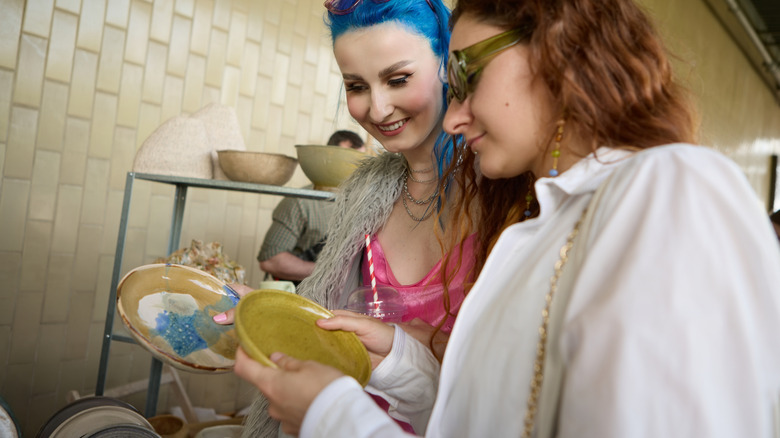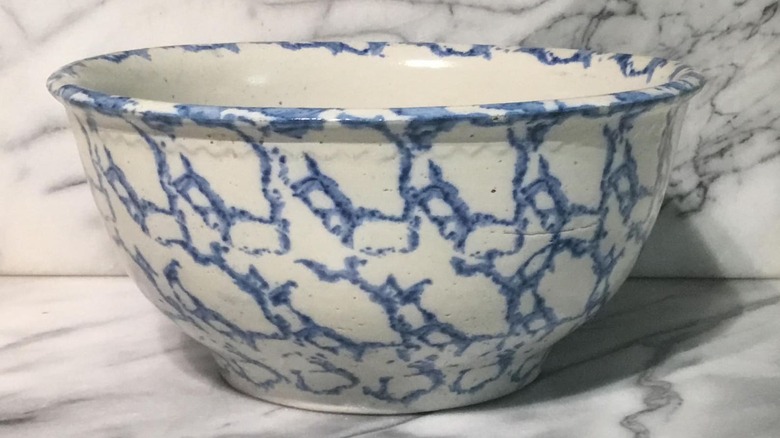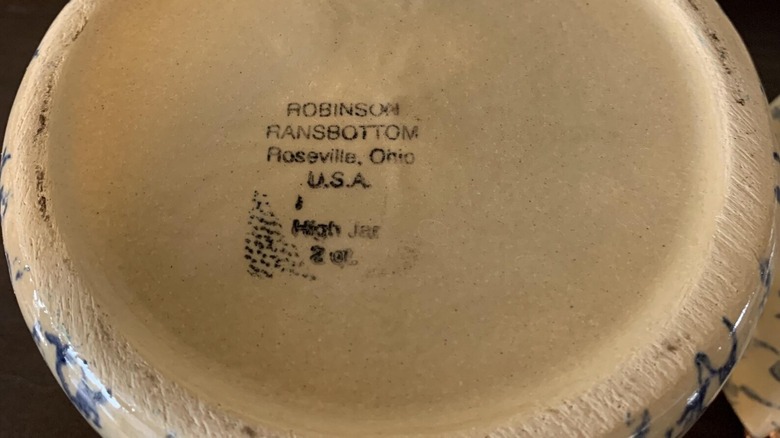The Treasured Collector's Item You'll Want To Grab For Your Home If You See It Thrifting
If you've ever wandered into a thrift store and spotted a heavy, speckled dish or a rustic-looking crock with a blue and cream pattern, there's a good chance it was spongeware. This style of pottery, also known as spatterware, was once popular for everyday kitchen staples like mixing bowls, pitchers, dinner plates, and crocks. The look comes from real natural sponges being used to dab glaze onto the ceramic by hand, giving it that layered, textural pattern collectors love. This ceramic technique has been seen as far back as Minoan times, but really took off during the 19th century in Ireland, Scotland, and England with earthenware. In the 19th and 20th centuries, the spongeware technique was often applied to stoneware as well.
If you happen to spot something from Roseville Pottery, a major American manufacturer that started in 1892 and shut down in the 1950s, you should grab it. Roseville pieces are highly collectible and can sell for hundreds or even thousands of dollars, especially if you score a full set. Next time you're on the hunt for something unique, look out for these dishes. They're one of the valuable items at a thrift store that others will likely pass up.
How to find vintage spongeware while thrifting
You're may be more likely to come across spongeware at thrift stores in the Midwest, especially around Ohio, where Roseville Pottery was based. But it can pop up anywhere in the United States from estate sales to antique malls, pawn shops, secondhand stores, and church rummage sales. Authentic pieces are usually quite heavy, may have some wear, and feature those unmistakable sponge-stamped patterns. Most vintage spongeware features a rich cobalt blue on a creamy base, but you'll also find pieces in soft reds, greens, and light blues. If you discover a piece with a maker's mark on the bottom, you may have struck gold. But even unmarked pieces can be valuable, particularly if they have a nice patina, irregular glaze, or feel solid and well-made.
Once you bring your find home, you'll want to treat it with care. Hand wash it with warm water and a mild soap, keep it out of the microwave, don't put it in the dishwasher, and avoid displaying it in direct sunlight to prevent fading. Spongeware is as useful as it is beautiful, and there are many ways to decorate with this pottery in your home. Use a crock as a utensil holder or flower vase, stack dinner plates on open shelving, or mix modern flatware with these vintage dishes for a curated table setting. You can even group pieces by color for a layered, lived-in look.
Spotting the real deal vs fake spongeware
Because spongeware has surged in popularity, there are plenty of modern replicas hoping to cash in on the trend. These pieces are usually lighter, more polished, and have very even, perfect patterns — often printed on rather than sponge-stamped. Vintage pieces, on the other hand, will tend to show their age in the best ways. True craftsmanship may leave behind smears and thumbprints from being hand-painted, slight glaze imperfections, uneven lines, and even small cracks and scrapes from years of use. If the bottom is totally smooth and pristine, it might be a new lookalike. If it looks like it lived through a few decades of kitchen duty, it's likely authentic.
Whether you're collecting a set or just finding beautiful ways to decorate your space, spongeware is one of those awesome thrift store finds that adds instant charm and history to your home — even if you purchase a modern replica instead of the real deal. But spongeware isn't the only valuable item you can snag while thrifting. Check out these vintage chairs you shouldn't overlook if you happen to see them at the thrift store.


